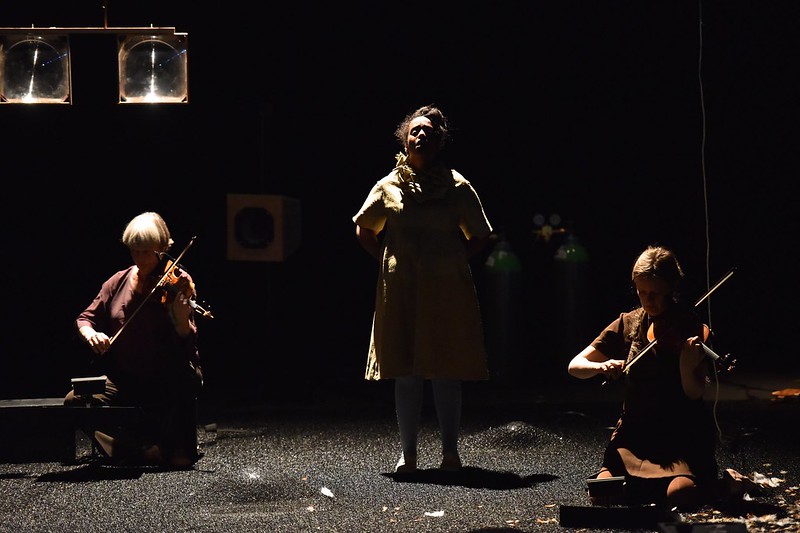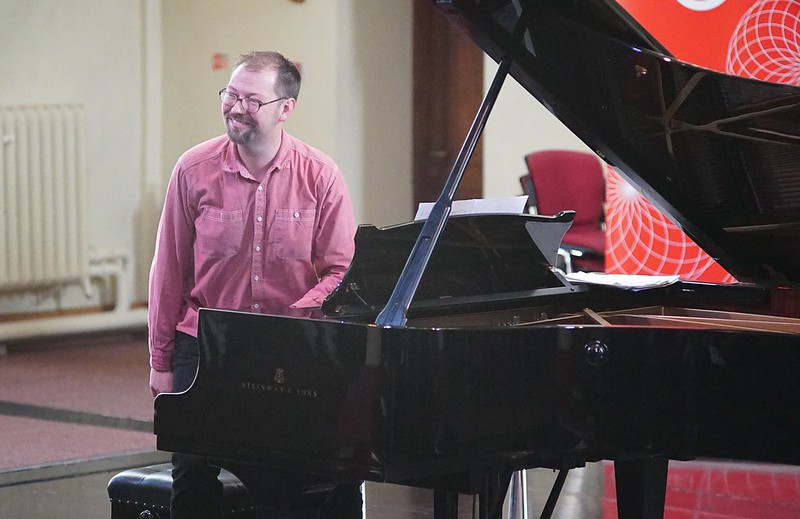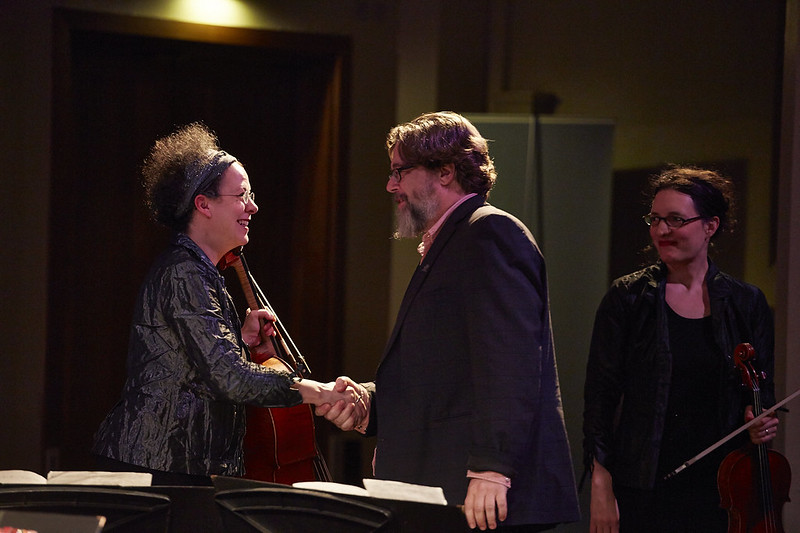The programme book with beautiful monochromatic painting by Jacqueline Humphries.
It’s odd what one comes to remember.
With a situation as inundating as Huddersfield Contemporary Music Festival one
expects certain listening experiences to sail away into the distance, whilst
others have a greater effect; but the level of this disparity in this case is
surprisingly large, at least considering my own tired grey-matter. As always
there was much to see, and I saw an awful lot—and even that was by no means
everything, even half of what was on offer.
Before I say anything else about this
festival, one thing ought to be cleared up right away: ticket prices. From
those whom I’ve spoken to, insiders, listeners etc., the feeling was on the
whole that prices were too high and perhaps have been for some time—too
high given the quantity and intensity of available performances; and sometimes
too high given the quality of certain
performances. It seems likely that the ticket prices reflect a general lowering
in the level of funding apportioned to the festival. But noticeable this year
was the quantity of foreign funds—Norwegian money in particular this year did
quite a fair bit of talking. The Norwegians appear to have more in the way of neuen Musik infrastructure than, say,
England—this isn’t really an exaggeration—such that one wonders just how much
of an adjunct to physical-resource money (er, fossil-fuel money) contemporary
classical-land is. Redirect the flow of funding, or have a change of policy, as
the Dutch have recently, and things can dry up overnight.
All of that said, the number of
attendees was very considerable. Empty seats were difficult to come by—such
that one wonders that concert price architecture may well have been designed to
draw a particular demographic in.
Additionally, being as I am endowed with relative youth, I could utilise the
under-25s ‘cheapskates’ scheme—and I would suggest people who pass for this age
give it a go as I was never required to display ID. Suggest but not endorse.
*
Elsa flanked by spectral violinists. Photo: Brian Slater
But, the music. I want to focus on two
dramatic commissions, plus one re-performance. There were other important
things I feel I need to mention—perhaps I will get to them in due course.
First, though, this ad hoc trilogy of ‘operas’.
Sciarrino’s Lohengrin, Simon Steen-Andersen’s
Buenos Aires and Tim Parkinson’s Time With People. There was an odd
continuity, in some ways, between these items—despite great differences of
style and approach. All three of these pieces are, or were, eschatological, or
post-apocalyptic. They emerged in a space beyond history, or after a moment of
great forgetting. They all implied a certain fundamental reconstruction, from
first principles. They all included some aspect of, perhaps forcible,
restriction. They all depicted individuals who were itinerant, homeless, lost;
lost whilst not even realising the full extent of their lostness.
Lohengrin,
like so much Sciarrino, is an
attempt at one level to build a kind of language, and a failure to say anything
at all. Sciarrino speaks in tongues even when he means to speak with
neologisms. And not only that, but Sciarrino’s tongues are flat—they waft with
great sophistication, they create great (to use Jacques Rivière’s choice
descriptor) ‘sauce’—and as Bryn Harrison said to me ‘it’s a world I simply enjoy entering into’.
‘But is there anything there?’ I said.
Bryn paused; but then said, ‘no’.
It is of course unfair to frame it in
this nationalistic a way, but Sciarrino’s music is, however one looks at it,
deeply Italian. The abundant slow-sustain-to-fast-downward-cascade gesture in
his music, present in the opening of Vanitas,
and cropping up in nearly everything since then, is a kind of tic. It could
even be a self-portrait: Saaaal-vatore… Sciiiii-arino (you get the picture).
This nevertheless is the flaw with
Sciarrino’s work; why his least ‘dramatic’ pieces (like, say, his music for
television Sui Poemi Concentrici, his
efforts for the ‘flattest’, most time-extended medium) are his most successful;
that for all his efforts to be dramatically otherwordly, he never escapes
gesturing towards his own palette. Elsa in Lohengrin
is a schizophrenic not because she is necessarily determined to be so, or
because dramaturgically it is impossible for her not to be; but because
Sciarrino wants an excuse to continue with his idiomatic stylisms, and to have
a schizophrenic at the centre of the drama is terribly useful in this regard. She
whispers not because she can’t speak loudly, but because Sciarrino likes the
sound of whispers.
Johanna is tried. Photo: Brian Slater
But for everything that was stylish
about Lohengrin, the antithesis was
to be found in Simon Steen-Andersen’s Buenos
Aires. The piece didn’t necessarily begin well—one senses that
Steen-Anderson doesn’t much like song; certainly not opera, so the commission
might on first glance seem a poor idea. The main character of Johanna, who is a
kind of audience-cypher, is drafted into a dreamlike recording session—laden with
heavy discussions about the nature of operatic expression as such. One can feel
Steen-Andersen’s mind-cogs clanking—but it’s a dummy, a feint. Shortly, Johanna
is transported to a dystopian parallel existence, where, apparently, all this
damn singing is justified. The piece exists to reconfirm Steen-Andersen’s
fascination with reconfigured action; with confined-ness and chambered-ness. But
here it is Johanna as a dramatic character, a person, rather than just a body
on legs, who is chambered. Her voice-box removed, her body transplanted to an
accidental post-apocalypse, it is her character which suffers, with apparently
no explanation.
As it goes on Buenos Aires gets better and better. Steen-Andersen’s now apparently
ubiquitous use of small cameras as extensions of the performers bodies doesn’t
feel forced. Indeed the piece transcends the feeling of gimmick present in much
of his earlier work; there is a great impenetrable darkness here, and the piece
in the end has little to do with what is actually asked of the players or
performers.
The Argentinian city, where Steen-Anderson
lived for some years and studied, in the end comes to represent for him the
origin of the world—in the sense of Courbet perhaps. But it is also the place
where the world goes to find out if it’s still alive at all—one thinks here of
Huxley. As a place defined by its having been ‘confined’, succumbing to censorship
by the regime, it represents the Latin American origin of what might have been
assumed to be a post-Protestant tendency in Steen-Andersen’s work. The
transformation of the malicious studio producer character, into tyrannical judge,
into the pro-censorship academic (read: Richard Taruskin) is a marvellous piece
of dramatic chicanery.
The piece in the end felt like a very
sophisticated fringe-theatre event—not an opera or musical in any conventional
sense. And stylistically there was plenty to be a bit irritated by (the piece
continues Steen-Andersen’s studenty love affair with the imagery of the
computer age—though here, possibly unintentionally, it has a kind of ‘90s
revivalist tinge so modish presently). On the other hand, I found it welcome,
and hilarious, to ask members of the elite Stuttgart
Vokalensemble to sing Rossini through shop-bought voice modifiers and
high-pressure air hoses. But these gimmicks, such as they are, were transcended
in the end towards the service of a much more substantial thematic world; they
weren’t the point of the piece. It certainly seems to me to be the best thing
he’s yet achieved.
Beavan Flanagan and David Pocknee answer questions. Photo h/t Mira Benjamin.
However it was really Tim Parkinson’s ‘opera’
Time With People that was why I was
excited for this year’s festival. I had seen Act 1—where two people answer
questions to an incongruous soundtrack of astringent beeps and Rossini—performed
a few times, not least by Parkinson Saunders (i.e. the duo Tim has with James Saunders),
but the rest of the ‘opera’ remained a mystery; to everyone else as well no
doubt. Oddly though, even though James wasn’t involved in this performance, it
is really as an extension of Parkinson Saunders that this piece lives. The
idea of ‘any sound-producing means’, and by extension, object detritus, is
central both to Time With People and
Parkinson Saunders.
Here however, there is a much darker
turn—as least, as far as I could see. While performances with James have in the
past been frivolous, nonchalant, quietly critical, even cynical at times, they
remain fundamentally fairly bright. While there is a whole topic to be broached
of darkness in James Saunders’ own late ‘instruction’ pieces (think of the
Milgram experiments), Tim’s work has always been more difficult to pin down. Indeed
his instrumental music remains so. But it isn’t so with his ‘opera’. Time With People might be the blackest
thing Huddersfield has ever programmed—certainly in the way Philip Thomas
arranged the performance, but I’d argue even beyond this. After the initial entrée
of questions-answered (deadpan, but here the thought arises: to whom is one
addressing these answers?) an itinerant band of onlookers slowly makes its way
across a landscape strewn with years of accumulated debris. They drift like
ghosts or victims of some epidemic. What follows is a foray into Tim’s rhythmic
colloquy writing, and prosaic language, akin to Stein (along the lines of ‘I
like to be with you and you like to be with me and both of us like to be
together’… drumhit). But there are
onlookers. We all like to be together, watched.
From here the scene collapses. Objects
are hit rhythmically; until after some fizzling out and rearrangement, this
band ends up singing what they hear over headphones. There is an incessant drumkit
pattern. They bark descriptions of the sounds they hear (again, who for?);
guitars are played; there is revelling, a dance. Occasionally a sound will ring
across the floor causing them to lie down, only shortly to get back up again. And
finally what emerges is the detritus-objects themselves taking over. These
people must assemble them in boxes and drop them rhythmically onto the floor,
to a soundtrack of Handel (and occasional barked words ‘we all together/alone’
etc.). The objects getting smaller and smaller until, all the music over, tiny
things of, as Parkinson puts it ‘1g or less’ fall to the floor. Fade to black
abruptly.
This is a world in which music is a
kind of memory—something that must be reconstructed from the ground up, and
afterwards returned to the same ground. Only three LPs (the analogue record-grain-noise
remains on the recordings used) are left. Music is reduced to complete first principles—in the end, the downbeat alone. This was music that brought to my
imagination A Canticle for Leibowitz,
or perhaps more extremely, Mick Jackson’s Threads.
And, not surprisingly, Time With People does
somewhat colour what Tim and James have been doing all along. Their songs (see below) one
imagines might have been dug up out of the ground like the copper tablets in
Will Self’s The Book of Dave.
And certainly Time With People should be done in London some time soon, at least
so we can all come and stare again at the abyss of nihil that Tim has so
dextrously created.
*
Further things to mention that caught
my ear this festival…
Philip Thomas. Photo: Andrew Stavely
Philip Thomas’s wonderful piano
performances—of a new(ish) work by Michael Finnissy, with a devastating ending
(as only his endings can be), which I deeply want to hear again. He also
presented a new piece by Christian Wolff, Sailing
By, which indeed did in its amiable way. The multiple pianos a few days
later were also wonderful, including Wolff’s amazingly unperformed-since-the-premiere
Sonata for Three Pianos and Feldman’s
beautiful Piece for Four Pianos. (He
also did a sterling job herding the Edges Ensemble through a maze of dug-out Scratch
Orchestra pieces in the Hepworth Wakefield—an overwhelming experience, at least
for myself not least because I’d never seen any of the Hepworth’s amazing
collection of visual work either.)
There was further Wolff wondrousness in
the presentation of For Magnetic Tape II
by Robert Worby and the Langham Research Institute. This is a totally wonderful
piece that surely deserves to be heard on record. In terms of sheer quality and
bravado it’s certainly there with Williams
Mix; in fact I might even prefer it in its similar brevity and even greater
wit and timing.
Laurence Crane’s expanded Some Rock Music for Alan Thomas and the UK
Premiere of Sound of Horse were
highlights of the Monday free-day. Sound
of Horse we can add to Crane’s late ‘weird’ pieces—though amazingly for
Crane, at points it seems long-winded(!).
It left me wondering just how Laurence will tackle longer forms—[edit: I've written a long essay about this very thing, see above!]
I haven't included Christopher Fox's
Widerstehen in the above discussion, but I could have done easily. There is
much to say about it, and like so much of Christopher's work it is
sophisticated and moving. All of that said, there were specific problems with
it, on the level of dramaturgy, that I felt were unresolved. It remains a
beautiful work nonetheless.
Martin Arnold with the Bozzini sisters. Photo: hcmf
The contribution of Quatour Bozzini was
also a highlight for me. Not only were they featured in the continuation of
their project ‘Composers’ Kitchen’, with a new, and rather pretty piece by Leo
Chadburn (aka Simon Bookish), a fairly major work by Jimmie LeBlanc (new to me)
and further new pieces by Stephen Chase and Luke Nickel, which I missed sadly.
Not only that, but they also performed
a marvellous concert, featuring Marc Sabat’s very interesting Euler Lattice Spirals Scenery, and a
wonderful quartet, Contact; Vault, by
Martin Arnold. Arnold, who had been mentoring the composers in the ‘Kitchen’,
was, shamefully, entirely new to me. As it turns out, he is the most important living
Canadian composer and uniquely talented, one should think a pretty major voice
internationally. He—to my amazement, as this is perhaps a language I’d been
searching for but thought impossible—is that unique composer who links the melodic
world of folk music and monody with the quietism and durational extension of Wandelweiser.
Antoine Beuger and Jurg Frey, for example, are admirers and the latter has
performed his music with the Bozzini Quartet. I guess one finds out about
people in one’s own time; and in my defense, Arnold is criminally under-recorded
and under-documented (he lacks, for example, a Grove article despite many more
minor and younger figures being represented). Nevertheless, catch him while he’s
in the country—as Arnold is giving a talk at Brunel University on the 4th
December.
(I must also say thanks to various
people in Huddersfield for being accommodating hosts and putting up with my incessant
mewlings on this or that: Richard Glover, Philip Thomas, Bryn Harrison, Mira
Benjamin, Stephen Chase, John Fallas, Simon Reynell, and others, as well as Sam Wigglesworth, Alex
Nikiporenko; and also Chloe Glover and Rita Kybaite. I look forward to joining
the department next year—it was great fun to meet lots of new people…)






No comments:
Post a Comment